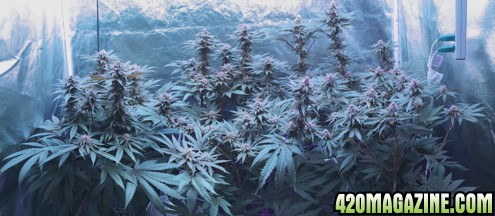Invented by the genius Nikola Tesla in the 1890's, Electrode Less Fluorescent Discharge Lighting has always been superior to other forms of lighting. It uses less electricity and lasts several times longer than other lighting systems before needing replacement — as much as 100,000 hours. Inda-Gro's EFDL lights are far superior to ordinary HID lighting because the spectrum of light they emit is specific to your plants' need for light. They also use 70% less electricity, operate warm, not hot, so no heat energy is wasted, and last forever without leaking gas and losing intensity the way other lighting systems do.
Ordinary fluorescent lighting leaks gas around the electrodes and wears out much faster than EFDL lighting. Incandescent and HID lighting operate through electrical resistance, and give off a lot of heat. The energy waste increases as the wattage goes up - the heat attracts bugs while killing the plants, and the cooling system is friendly to mold. Along with that big electric bill you get the variety of health problems for your plants and yourself that heat, mold, and bugs create.
Inda-Gro has created a lighting system, its PRO 420 PAR light, that is specifically designed to emit wavelengths that will be used by your plants. Using Tesla's EFDL as a starting point, Inda-Gro has engineered the ideal lighting system for growing plants! Other manufacturers offer EFDL lights, but no one but Inda-Gro combines EFDL with LED and Electronic Diode lighting to deliver all the red and far red wavelengths your flowering plants need — even sunset!
You wouldn't warm a hamburger with X-Rays, would you? You would use infrared lighting like restaurants do. But both X-Rays and infrared are forms of light energy, an energy that can measured in term of light wavelengths. X-Rays are less than 10 nanometers in length, while infrared light occurs in the light spectrum above 700 nanometers. Big difference, right? In between is visible light
Most visible light, especially sunlight, falls between 500 and 600 nanometers. The vegetative stage for plants is most active when lit with wavelengths 400 to 520 nanometers in length, where photosynthesis peaks. The absorption of chlorophyll and growth of the buds in the flowering stage peaks at the other end of the visible light spectrum, where 610 to 720 nanometers is the 'red band' of light wavelengths best for plants in the flowering stage. INDA-GRO has engineered its EFDL lights with rare earth metals that emit light in wavelengths specific to your plants growing and flowering stages. Other lights, especially HID, waste your time and money emitting light spectrum wavelengths that, while appearing painfully bright to the unaided eye, are of no value to you the grower. Inda-Gro is target on, emitting light spectra that are specific to your plants' needs.
You can buy 'red' lights, fluorescent and LED lighting, but be careful about that 2100 Kelvin rating that is so often found on the label. Those 'red' flowering stage grow lights are emitting light entirely at the low end of the red spectrum. Only Inda-Gro PAR 420 light gives you all of that red spectrum.
While much of the sunlight spectrum is not utilized by the plant, sunlight does vary from sunrise to sunset — it varies in intensity and in the kind of light wavelengths that fall on the earth. The far red spectrum of sunlight is very important to the growth of flowers, and Inda-Gro's Par 420 light is specially engineered with patented controls to reproduce the 740 nanometer wavelength that falls on the planet Earth with declining intensity as the sun falls below the horizon each evening.
The patented PRO 420 PAR light pontoons — yes, pontoons — attach to either side of the grow light. There are both 660 nm Deep Red diodes and 730 nm Far Red diodes operating through these pontoons. During the day, when the lights are on, the 660 nm diodes are positioned to let this Deep Red light distribute throughout the canopy, a light that is absorbed by Chlorophyll B. This increases the number of flowering sites. Your pontoons are plugged into the same timer as the EFDL. When the power is cut in the evening, the 730nm Far Red diodes become active, powered by lithium ion batteries. After 5 minutes, the lights gradually turn off, one by one, mimicking the declining Far Red light that occurs in every cloudless sunset.
This 730 nm light is what triggers the phytochrome response — your flowers actually grow and increase in size at night. That 730 nm far red light is a signal to the plant to start growing flowers and fruit. What happens without sunset? Under all other grow light systems currently available, it will take two hours for the plants to 'relax' and flowering begin. With Inda-Gro's pontoon lights attached to your PRO 420 Par, the flowering response begins immediately. Inda-Gro reports that its tomatoes are a good third bigger because of the improved flowering response. Six and seven ounce tomatoes become eight and ten ounce tomatoes with the addition of the pontoons.
Obviously, Inda-Gro has put a lot of research into developing the ideal lighting system for indoor and greenhouse grows. Because your plants are important to you, you owe it to yourself to contact Inda-Gro and find out how you can get this light. Remember that Inda-Gro is a US manufacturer. Just because a light appears blue or red does not mean that you are getting the kind of light spectrum you need for growing plants. Buy American, and buy the best. All of the information here is available at the
Inda-Gro | Grow Lights | Induction Lighting website.





